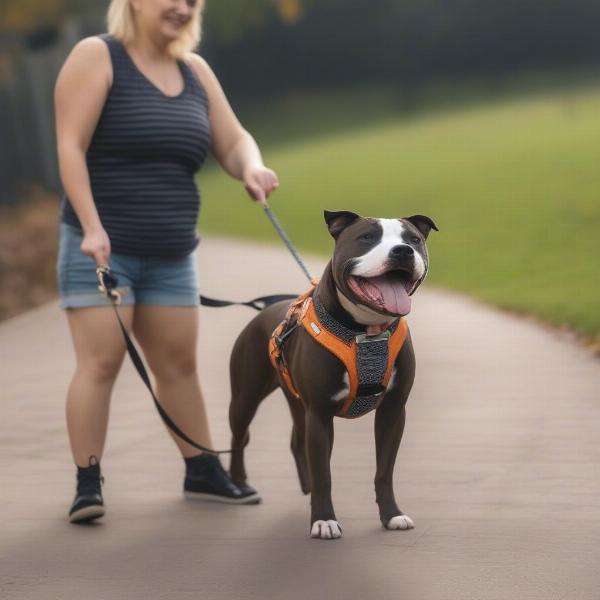Choosing the right harness for your Staffordshire Bull Terrier is crucial for both their comfort and your control. A well-fitted harness can make walks more enjoyable, training sessions more effective, and even help manage pulling. But with so many options available, how do you choose the best one for your Staffy? This guide will walk you through everything you need to know about harnesses for Staffy dogs, from different types and fitting tips to training advice and safety considerations.
Understanding Your Staffy’s Needs
Staffordshire Bull Terriers are powerful, muscular dogs known for their spirited nature. This breed’s strength and sometimes stubborn personality necessitate a harness that provides both security and control without compromising comfort. When selecting a harness, consider your Staffy’s age, activity level, and any specific training goals you might have. A young, energetic Staffy might benefit from a harness designed for pullers, while a senior dog might require a more supportive and comfortable option.
Types of Harnesses for Staffy Dogs
Choosing the right type of harness depends on your individual Staffy and your training goals. Here’s a breakdown of the most common types:
- Front-Clip Harnesses: These harnesses clip in the front, on the dog’s chest. When your Staffy pulls, the harness gently steers them back towards you, discouraging pulling. This is a good option for dogs who are just starting leash training or who tend to pull excessively.
- Back-Clip Harnesses: These harnesses clip on the dog’s back. They’re generally comfortable for everyday walks and offer good control. However, they may not be as effective for managing pulling as front-clip harnesses.
- Dual-Clip Harnesses: Offering the best of both worlds, dual-clip harnesses feature clips on both the front and the back. This versatility allows you to switch between front-clip training and back-clip walking.
- No-Pull Harnesses: Designed specifically to discourage pulling, these harnesses often feature a tight fit around the chest and underarms. While effective for strong pullers, they can be uncomfortable if not fitted correctly.
Finding the Perfect Fit for Your Staffy
A properly fitted harness is essential for your Staffy’s comfort and safety. A harness that’s too tight can restrict movement and cause chafing, while a harness that’s too loose can allow your Staffy to escape.
Follow these steps to ensure a perfect fit:
- Measure Your Staffy: Use a measuring tape to measure your Staffy’s girth (around the deepest part of their chest, behind their front legs) and neck.
- Consult the Size Chart: Refer to the manufacturer’s size chart to determine the appropriate harness size. Don’t rely solely on weight; girth measurement is crucial.
- Adjust the Harness: Most harnesses are adjustable. Adjust the straps to ensure a snug but comfortable fit. You should be able to fit two fingers between the harness and your Staffy’s body.
- Check for Chafing: After a few walks, check your Staffy for any signs of chafing or rubbing, especially around the armpits and neck.
Training Your Staffy with a Harness
A harness can be a valuable tool for training your Staffy, especially when it comes to leash manners. Start by introducing the harness gradually, associating it with positive experiences like treats and praise.
 Training a Staffy with a Harness
Training a Staffy with a Harness
Harness Safety Tips
- Never leave your Staffy unattended while wearing a harness.
- Regularly inspect the harness for wear and tear.
- Choose a harness made from durable, high-quality materials.
Conclusion
Selecting the right harness for your Staffy is an important decision that can significantly impact their comfort and your control during walks and training sessions. By considering your Staffy’s individual needs, researching different harness types, and prioritizing proper fit, you can ensure a positive and enjoyable experience for both you and your furry friend. Investing in a quality harness is an investment in your Staffy’s well-being and your peace of mind.
FAQ
- What is the best type of harness for a Staffy puppy? A front-clip harness can be a great choice for puppies, helping to discourage pulling early on.
- Can I use a harness for crate training? No, harnesses should not be used during crate training as they can pose a safety hazard.
- How often should I clean my Staffy’s harness? Clean your Staffy’s harness regularly, following the manufacturer’s instructions.
- My Staffy keeps slipping out of their harness. What should I do? Ensure the harness is properly fitted and adjusted. You may need to try a different size or style.
- Can I use a harness for running with my Staffy? Yes, many harnesses are suitable for running, but ensure it’s comfortable and secure.
- Are there any harnesses specifically designed for Staffies? While there aren’t breed-specific harnesses, certain types are better suited for Staffy’s build and temperament.
- How much should I expect to spend on a good quality harness for my Staffy? Prices vary depending on the brand and features, but a good quality harness can range from $20 to $50.
ILM Dog is your trusted source for expert advice on all aspects of dog care and breeding. We provide reliable, practical information for dog owners worldwide, covering everything from breed selection and health care to training and nutrition. We’re passionate about helping you provide the best possible care for your canine companion. For further assistance, please contact us at [email protected] or +44 20-3965-8624. ILM Dog is committed to providing comprehensive information on dog care, including breed selection, health, training, nutrition, grooming, and product recommendations. Our expertise can guide you in choosing the perfect harness and other essential accessories for your Staffy.